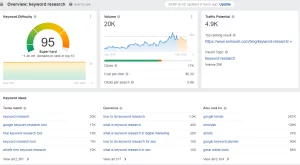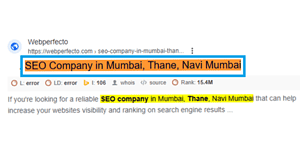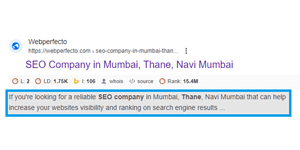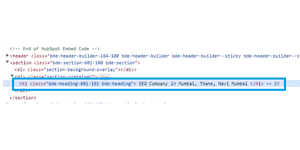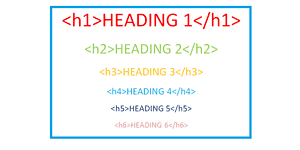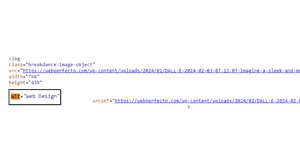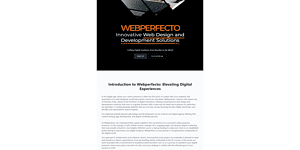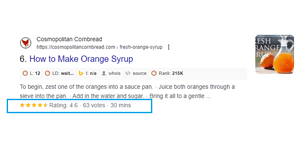Welcome to the Ultimate Guide on On-Page SEO, your comprehensive resource for website optimization. This guide delves into essential strategies like keyword placement, meta tag optimization, and content structuring to boost rankings and drive organic traffic.
What is On-Page SEO
On-page SEO refers to the optimization techniques employed directly on a website's pages to enhance its search engine visibility and ranking.
It involves fine-tuning elements such as meta tags, headers, content, and URL structures to align with relevant keywords.
Proper keyword placement, compelling meta descriptions, and relevant, high-quality content are crucial for on-page SEO success. Additionally, optimizing images, improving page load speed, and ensuring mobile-friendliness contribute to a positive user experience, further boosting search rankings.
By focusing on these on-page factors, website owners can increase their chances of ranking higher on search engine results pages and attracting more organic traffic.
Importance of on-page SEO
On page seo plays a pivotal role in enhancing a website's visibility on search engines by optimizing individual pages for specific keywords.
By strategically placing relevant keywords in meta tags, headers, and content, on-page SEO helps search engines understand the content's context, leading to improved rankings.
Furthermore, it significantly contributes to a positive user experience by ensuring that the content is not only keyword-rich but also engaging and informative.
User-friendly features like mobile responsiveness and fast page load times, which are part of on-page optimization, further enhance a website's appeal to both users and search engines.
As search engines evolve, prioritizing on-page SEO elements becomes crucial for businesses seeking to rank higher and attract organic traffic, making it an integral part of any comprehensive digital marketing strategy.
Key On-Page SEO Elements
- Keyword Research
- Meta Title Tags
- Meta Descriptions
- Heading Tags
- URL Structures
- Image Alt Text Optimization
- Content Quality and Strategic Keyword Placement
- Internal Linking Strategies
- Mobile Optimization
- Enhancing Page Load Speed
- User Engagement Metrics
Keyword Research
- Keyword research is essential for on-page SEO. It helps identify terms people use when searching for information on search engines. By understanding these terms, businesses can optimize their content to match user intent.
- Effective keyword research techniques uncover high-volume, low-competition keywords. This enables websites to rank higher in search engine results pages (SERPs) and attract more organic traffic.
- Moreover, it aids in content creation by providing insights into topics of interest to the target audience. This ensures that content remains relevant and appeals to users, enhancing engagement and retention.
- Keyword research also assists in strategic planning, and guiding the development of SEO campaigns. It enables businesses to prioritize efforts and allocate resources effectively for maximum impact.
- Furthermore, ongoing keyword research allows businesses to adapt to changes in user behavior and search engine algorithms, maintaining competitiveness and visibility in the ever-evolving digital landscape
Meta Title Tags
Title tags are a fundamental component of on-page SEO, serving as concise and descriptive labels for individual web pages. Positioned within the HTML code, title tags define the page's primary topic and play a crucial role in search engine rankings.
Crafting compelling title tags involves incorporating relevant keywords that accurately represent the content. These tags not only influence search engine algorithms but also serve as clickable headline in search results, impacting user engagement.
An effective title tag is not only keyword-rich but also captivating, encouraging users to click through and explore the content. Mastering title tag optimization is essential for enhancing a webpage's visibility and attracting organic traffic.
Meta Descriptions
Meta descriptions play a crucial role in on-page SEO, serving as concise summaries that provide a snapshot of a webpage's content.
Situated below the title tag in search engine results, meta descriptions aim to entice users to click through to the page.
Crafting compelling meta descriptions involves incorporating relevant keywords while delivering a clear and enticing message.
While search engines no longer use them as a direct ranking factor, well-crafted meta descriptions contribute to higher click-through rates, enhancing a page's overall performance in search results.
An effective meta-description not only informs users about the content but also encourages them to choose a particular page over others.
For more tips and strategies, explore our guide on Best Practices for Meta Descriptions in On-Page SEO.
Heading Tags
Utilizing heading tags is a fundamental practice in SEO, contributing to both the structure of a webpage and its visibility on search engines. Heading tags, ranging from H1 to H6, create a hierarchical organization within the content, guiding both users and search engine crawlers through the information. The H1 tag typically represents the main heading of the page and holds significant weight in conveying the primary topic. Subsequent heading tags (H2, H3, etc.) delineate subtopics and content sections.
Strategically incorporating keywords into heading tags reinforces the page's relevance to search queries. Well-structured content with clear heading hierarchies not only enhances readability but also signals the importance of specific information to search engines, positively impacting SEO efforts.
URL Structures
URL structures in SEO play a crucial role in both search engine rankings and user experience. A well-organized and descriptive URL provides valuable information about the content of a webpage. Search engines use this information to understand the context and relevance of a page to specific queries.
Clean and readable URLs with relevant keywords contribute to higher visibility in search results. Users are more likely to click on a link with a clear and meaningful URL, as it conveys trustworthiness and professionalism. Additionally, search engines favor URLs that are easy to interpret, contributing to better indexing and ranking.
An optimized URL structure not only benefits SEO but also enhances user navigation and understanding of website content. By incorporating relevant keywords and maintaining simplicity, businesses can create a positive impact on both search engines and their audience, ultimately improving their online presence.
Learn more about How to Create SEO-Friendly URLs for On-Page Optimization to maximize your website’s potential.
Image Alt Text Optimization
Alt text, or alternative text, is a descriptive attribute added to HTML image tags, providing a textual description of the image's content. This not only ensures that users with visual impairments can understand the image but also helps search engines comprehend the context of the visual content.
When optimizing alt text, it's essential to be descriptive and incorporate relevant keywords, providing an accurate representation of the image's purpose within the content. Search engines use this information to index images, enhancing the overall SEO of the webpage. Moreover, well-optimized alt text can attract traffic from image searches, broadening the reach of the content.
Incorporating Image Alt Text Optimization into your SEO strategy not only improves website accessibility but also positively impacts search engine rankings, making your visual content more discoverable and engaging for a wider audience.
Read more about Best Practices for Optimizing Images in On Page SEO.
Content Quality and Strategic Keyword Placement
Content quality is paramount, as it determines the user's experience and engagement. High-quality content provides valuable information, addresses user queries, and establishes the website as a reliable source in its niche.
Strategic keyword placement within this quality content is equally crucial. Carefully integrating relevant keywords in titles, headings, and throughout the text enhances the page's visibility to search engines. It's imperative to maintain a natural and reader-friendly flow, avoiding keyword stuffing, which can have adverse effects on user experience and SEO.
By striking the right balance between content quality and strategic keyword placement, a webpage not only caters to the needs of its audience but also aligns itself effectively with search engine algorithms, ensuring better rankings and increased organic traffic.
Internal Linking Strategies
Internal linking is a crucial aspect of on-page SEO, involving the strategic connection of pages within the same website through hyperlinks. These links help establish a hierarchy and relationships between different pages, contributing to a more organized and easily navigable site structure.
The benefits of implementing effective internal linking strategies are manifold. Firstly, it enhances user experience by providing visitors with logical pathways to explore related content. This not only keeps users engaged but also encourages them to spend more time on the site, reducing bounce rates. Moreover, internal linking helps distribute link equity throughout the website, boosting the SEO value of various pages.
From a search engine perspective, internal links enable search engine crawlers to discover and index new pages more efficiently. By guiding crawlers through interconnected content, websites can ensure that all relevant pages are appropriately recognized and ranked in search results.
internal linking is a powerful SEO strategy that improves user navigation, reduces bounce rates, and enhances the overall visibility of a website in search engine results. Incorporating well-thought-out internal linking strategies contributes to a more robust online presence and a positive user experience.
explore our comprehensive guide on How to Use Internal Linking to Boost On-Page SEO and unlock the potential of this essential strategy for enhancing both user experience and search engine performance
Mobile Optimization
Mobile optimization is a critical component of modern website development and SEO strategy, ensuring that a website functions seamlessly and provides an optimal user experience on mobile devices. With the increasing prevalence of smartphones and tablets, catering to mobile users has become essential for online success.
Effective mobile optimization involves designing and structuring a website to be responsive and adaptive to various screen sizes. This includes adjusting the layout, images, and content to ensure readability and usability on smaller screens. Mobile-optimized websites often feature streamlined navigation, faster loading times, and touch-friendly interfaces, enhancing the overall user experience.
From an SEO perspective, search engines prioritize mobile-friendly websites in their rankings, reflecting the growing number of users accessing the internet on mobile devices. A mobile-optimized site not only improves search engine visibility but also reduces bounce rates and boosts user engagement.
prioritizing responsive website design is not just about keeping up with technological trends but is a fundamental strategy for reaching and retaining a broader audience, improving SEO performance, and staying competitive in the digital landscape.
Read more about The Role of Mobile Optimization in On Page SEO
Enhancing Page Load Speed
Page load speed, a critical factor in on-page SEO, refers to the time it takes for a webpage to fully display its content in a user's browser. It is a key element of user experience and plays a significant role in determining a website's performance on search engines, particularly Google.
In the realm of on-page SEO, page speed holds immense importance. Google considers it as a ranking factor, emphasizing the delivery of fast and efficient user experiences. A faster loading page not only enhances user satisfaction but also contributes to lower bounce rates and increased engagement.
The benefits of optimized page speed extend to search engine rankings. Google's algorithms favor faster-loading pages, considering them more user-friendly. Websites that prioritize page speed often find themselves with higher rankings in search engine results pages (SERPs). Google's commitment to delivering the best user experience drives the emphasis on page speed, making it a crucial aspect of on-page SEO strategy.
optimizing page load speed is not only about meeting user expectations but also about staying competitive in search engine rankings. It is a direct reflection of a website's efficiency and directly contributes to a positive user experience, ultimately influencing its position in Google search results.
User Engagement Metrics
User engagement metrics, such as bounce rate and click-through rate (CTR), are pivotal indicators in the realm of SEO, offering insights into how visitors interact with a website.
Bounce rate measures the percentage of visitors who navigate away from a site after viewing only one page. A high bounce rate may signal a lack of relevance or a poor user experience, impacting SEO negatively. Google interprets high bounce rates as a potential indicator that the content or user experience does not align with user expectations, potentially leading to lower rankings in search results.
On the flip side, a low bounce rate suggests that users find the content valuable and engaging. Content that keeps visitors on the site longer enhances the perceived quality and relevance, positively influencing SEO.
Click-through rate (CTR) is another vital metric, measuring the ratio of users who click on a specific link to the number of total users who view a page, email, or advertisement. A high CTR indicates that users find the content compelling and relevant. Search engines, including Google, may interpret a high CTR as a signal of quality and relevance, potentially boosting the page's ranking in search results.
Incorporating strategies to improve user engagement metrics is integral to a successful SEO approach. By understanding and optimizing bounce rates and CTR, website owners can create content that resonates with their audience, ultimately enhancing their online visibility and search engine rankings.--
Implementing Schema Markup and Rich Snippets
Implementing Schema Markup is a powerful strategy in the field of SEO, designed to enhance the way search engines understand and display content. Schema Markup, also known as structured data, involves adding specific code to a webpage to provide search engines with additional context about the content. This, in turn, allows for more informative and visually appealing search results, often displayed as rich snippets.
The purpose of Schema Markup is to make content more structured and comprehensible for search engines like Google, Bing, and Yahoo. By providing explicit information about different elements on a page, such as reviews, events, products, and more, Schema Markup enables search engines to create rich snippets – enhanced search results that display additional information directly on the search results page.
Rich snippets contribute significantly to increased visibility and click-through rates. When users see detailed information, such as star ratings, prices, and availability directly in the search results, they are more likely to click on the link. This not only improves the user experience but also boosts the chances of attracting targeted traffic to the website.
The SEO advantages of implementing Schema Markup are multi-faceted. First and foremost, it enhances the appearance of search results, making them more eye-catching and informative. This increased visibility often translates into higher click-through rates. Additionally, search engines may prioritize pages with structured data, leading to improved rankings.
Schema Markup is a valuable tool in the SEO toolkit. By making content more understandable to search engines and enabling the display of rich snippets, websites can enjoy enhanced visibility, improved click-through rates, and ultimately, a more favorable position in search engine rankings.
Types of Schema Markup
- Reviews
- Events
- Products
- Local businesses
- Rating
Securing Your Website with HTTPS
Securing your website with HTTPS is a fundamental step in safeguarding online data and ensuring a secure connection between your site and its visitors. HTTPS, or Hypertext Transfer Protocol Secure, is an extension of HTTP that adds an extra layer of encryption through the use of SSL (Secure Socket Layer) or TLS (Transport Layer Security) protocols.
The primary purpose of implementing HTTPS is to protect the integrity and confidentiality of the information exchanged between a user's browser and the website's server. This encryption prevents malicious actors from intercepting and tampering with sensitive data, such as login credentials, personal information, or financial details.
In addition to providing robust security, HTTPS has become a critical factor for search engine optimization (SEO). Major search engines, including Google, consider HTTPS as a ranking signal. Websites with HTTPS receive a slight boost in rankings, reflecting the importance placed on user security and privacy in today's digital landscape.
Securing your website with HTTPS not only protects your users but also enhances their trust in your site. Visitors are more likely to engage with a website that displays the padlock icon in the address bar, indicating a secure connection. This trust factor can lead to increased user confidence, improved conversions, and better overall online credibility.
Regular Content Updates
Regular content updates are integral to maintaining a dynamic and engaging online presence. Emphasizing the importance of consistently refreshing your website's content is not only crucial for keeping it relevant but also for boosting its performance on search engines.
Frequent content updates contribute significantly to the relevance and timeliness of your website. In the fast-paced digital landscape, where trends and information evolve rapidly, regularly updating content ensures that your audience receives the most current and accurate information. This commitment to relevance fosters user trust and loyalty, encouraging repeat visits and prolonged engagement.
From an SEO perspective, search engines like Google appreciate fresh and updated content. They interpret regularly updated websites as actively managed and valuable to users. This can positively impact search engine rankings, potentially leading to higher positions in search results.
Explore more on How Regular Content Updates Improve On-Page SEO to enhance your strategy.


